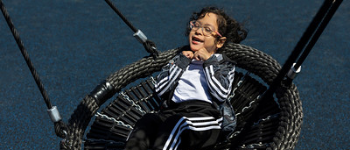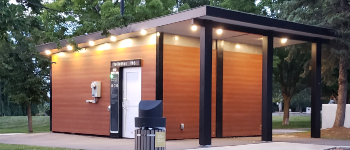There is a lot of terminology associated with accessible playgrounds, like ADA and inclusivity. If you’re working on an inclusive playground project, you may start to notice these terms and several others. No need to worry if you come across a term you don’t quite understand! To help you ensure safety, compliance with standards, and a super fun inclusive playground design, we constructed a glossary, a resource filled with common terminology about inclusive and accessible playgrounds. Keep reading to check it out and download it for free!
Glossary of Terms
Learning the important inclusive playground terminology is essential when designing a playground for every child’s unique needs. We constructed this glossary of common terms to help you and your community, and continue to open everyone’s eyes to the importance of inclusivity in playground design:
- Accessibility:Accessibility refers to the characteristics of products, services, and facilities that make them available to people with various disabilities.
- Accessible Design:Accessible design is a design process in which the needs of people with disabilities are specifically considered.
- Universal Design: The design of products and environments to be usable by allpeople to the greatest extent possible, without adaptation or specialized design.
- Compliant Design:Compliant designs, or compliant play structures, are made with physically disabled children in mind but not explicitly made for them.
- Inclusive Playground Design:Inclusive playground design is consistent with the concept of universal design. It recognizes everyone's right to participate fully and contribute to meaningful play.
- Accessible Route:An accessible route is a continuous unobstructed path connecting all accessible elements and spaces of a structure or play area. Accessible routes may include platforms, ramps, elevators, and lifts. Outside the play area, accessible routes include parking access aisles, curb ramps, crosswalks at vehicular ways, walks, ramps, and lifts.
- Play Component: An element intended to generate specific opportunities for play, socialization, or learning.
- Play Area:A portion of a site or facility containing play components designed for children.
- Elevated Play Component:A play component that is approached above or below grade and part of a composite play structure consisting of two or more play components attached or functionally linked to create an integrated unit providing more than one play activity.
- Elevated Accessible Route:An elevated accessible route is the path used for connecting elevated play components.
- Ground-Level Play Component:A "ground-level play component" is a play component approached and exited at the ground level.
- Use Zone:The ground level area beneath and immediately adjacent to a play structure or piece of equipment designated by ASTM F 1487 Standard Consumer Safety Performance Specification for Playground Equipment for Public Use for unrestricted circulation.
- Running Slope:The slope that is parallel to the direction of travel.
- Cross Slope:The slope that is perpendicular to the direction of travel.
- Clear Floor Space:The minimum unobstructed floor or ground space must accommodate a single, stationary wheelchair and occupant.
- Ramp:A walking surface that has a running slope greater than 1:20. Designers should provide ramp access to 50% of play components.
- Transfer Station: A transition point between a mobility device, like a wheelchair, and the ground. It helps kids of all abilities access the play area.
Click here to download your PDF copy.
Have you come across another term that you don’t see in our inclusive terminology glossary? Contact us today to discuss with one of our experts!








